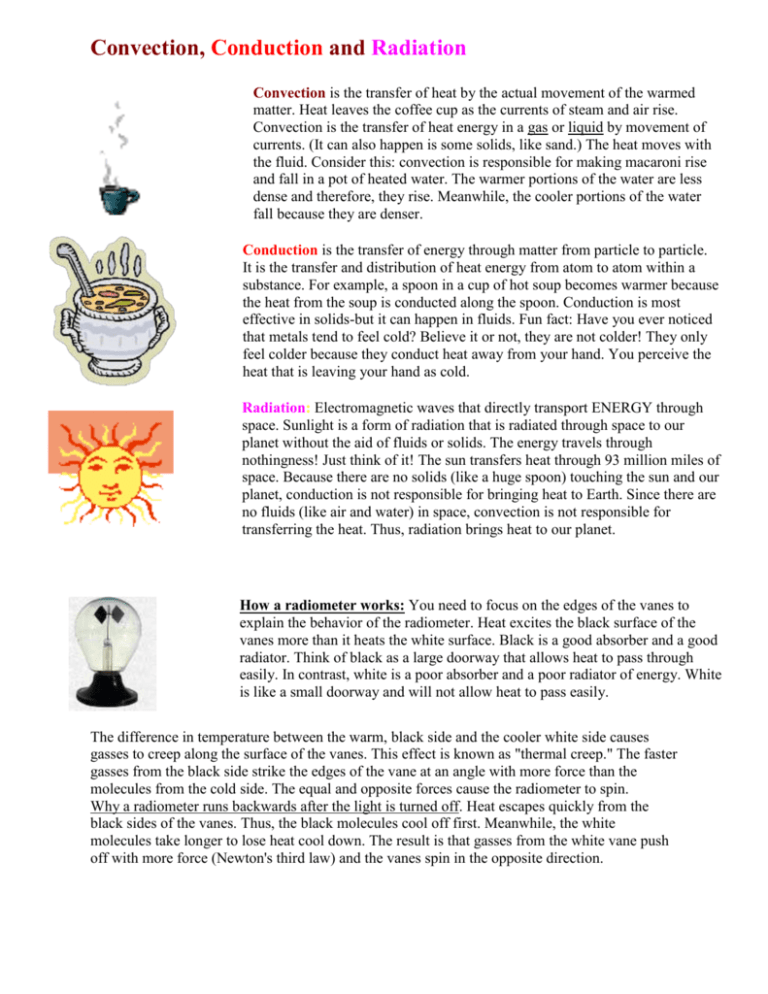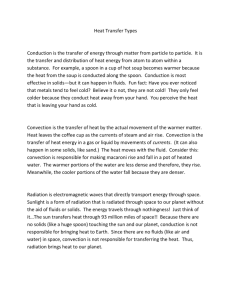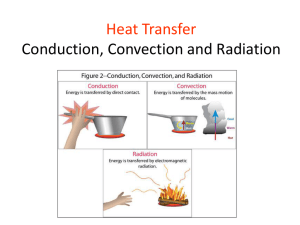Convection
advertisement

Convection, Conduction and Radiation Convection is the transfer of heat by the actual movement of the warmed matter. Heat leaves the coffee cup as the currents of steam and air rise. Convection is the transfer of heat energy in a gas or liquid by movement of currents. (It can also happen is some solids, like sand.) The heat moves with the fluid. Consider this: convection is responsible for making macaroni rise and fall in a pot of heated water. The warmer portions of the water are less dense and therefore, they rise. Meanwhile, the cooler portions of the water fall because they are denser. Conduction is the transfer of energy through matter from particle to particle. It is the transfer and distribution of heat energy from atom to atom within a substance. For example, a spoon in a cup of hot soup becomes warmer because the heat from the soup is conducted along the spoon. Conduction is most effective in solids-but it can happen in fluids. Fun fact: Have you ever noticed that metals tend to feel cold? Believe it or not, they are not colder! They only feel colder because they conduct heat away from your hand. You perceive the heat that is leaving your hand as cold. Radiation: Electromagnetic waves that directly transport ENERGY through space. Sunlight is a form of radiation that is radiated through space to our planet without the aid of fluids or solids. The energy travels through nothingness! Just think of it! The sun transfers heat through 93 million miles of space. Because there are no solids (like a huge spoon) touching the sun and our planet, conduction is not responsible for bringing heat to Earth. Since there are no fluids (like air and water) in space, convection is not responsible for transferring the heat. Thus, radiation brings heat to our planet. How a radiometer works: You need to focus on the edges of the vanes to explain the behavior of the radiometer. Heat excites the black surface of the vanes more than it heats the white surface. Black is a good absorber and a good radiator. Think of black as a large doorway that allows heat to pass through easily. In contrast, white is a poor absorber and a poor radiator of energy. White is like a small doorway and will not allow heat to pass easily. The difference in temperature between the warm, black side and the cooler white side causes gasses to creep along the surface of the vanes. This effect is known as "thermal creep." The faster gasses from the black side strike the edges of the vane at an angle with more force than the molecules from the cold side. The equal and opposite forces cause the radiometer to spin. Why a radiometer runs backwards after the light is turned off. Heat escapes quickly from the black sides of the vanes. Thus, the black molecules cool off first. Meanwhile, the white molecules take longer to lose heat cool down. The result is that gasses from the white vane push off with more force (Newton's third law) and the vanes spin in the opposite direction.











